Avery Close Up of Cooked Beef

This Holiday Brisket is one of my more popular brisket recipes for the Jewish holidays. It is inspired by a classic Ashkenazi sweet-and-sour brisket, but the flavors here are more subtle. This brisket is savory, aromatic, and subtly sweet with just a touch of tang. It's always a crowd pleaser!
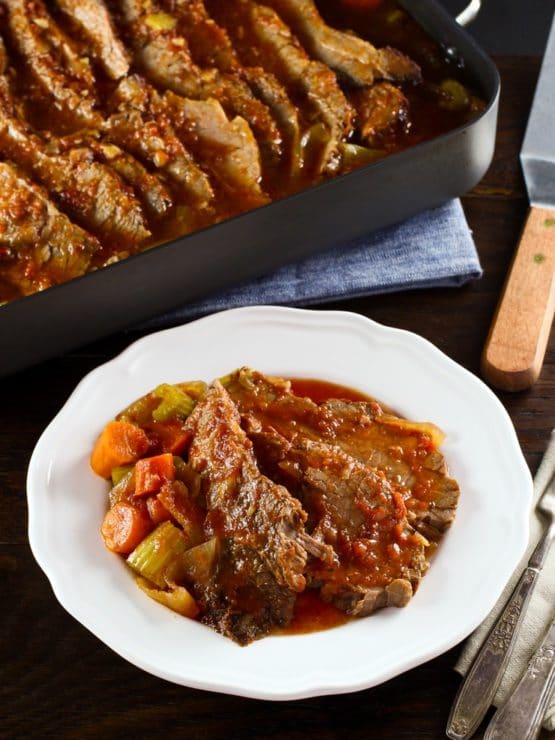
Jews living in Eastern Europe rarely had the money to buy better cuts of meat. They learned to make do with cheaper kosher cuts, like brisket, oft overlooked for its toughness. Cooking the brisket low and slow breaks it down, resulting in a tender piece of meat.
This Jewish tradition continues today, and brisket is often served for special holidays and occasions. On Shabbat, it is added to a pot with vegetables and potatoes to make a slow-cooked meaty stew known as cholent. At Rosh Hashanah, it is added to root vegetables with sweet dried fruits and slow cooked into tzimmes.
When Ashkenazi Jewish immigrants came to the United States, they brought their love of brisket with them. Jewish deli owners pickled the brisket to make corned beef or pastrami. But for the holidays, nothing could replace the comforting, hearty flavor of an oven-roasted brisket.
How to make brisket tender
The secret to a cooking brisket is twofold– brisket fat and time are key for tender and delicious results. Choose a cut with nice marbling; the more fat you can see, the more tender the meat will be. If buying grass fed (which tends to be leaner), make sure there is a fat layer and don't let the butcher trim it. And of course, allow yourself plenty of time to cook your brisket. If you can, make it a day or two ahead– the flavor will improve with time. More tips here: How to Cook Brisket – Tips and Recipes
My Holiday Brisket slow cooks for hours, so the final product flakes tenderly and simply melts in your mouth. The sauce is rich and flavorful, and the slow cooked vegetables are soft, like butter. The flavor is perfect for any special celebration, but particularly suited to the Jewish holidays. Enjoy!
What is traditionally served with Brisket?
Olive Oil Mashed Potatoes with Garlic and Rosemary
Roasted Rosemary Balsamic Tzimmes
Butternut Squash and Crispy Kale Bake
Green Beans with Balsamic Date Reduction Feta and Pine Nuts
Kale and Roasted Beet Salad with Maple Balsamic Dressing
Throwback Recording: In this radio interview with Joan Hamburg, we talked about this very brisket recipe, as well as Passover cooking. You can listen by clicking the triangle "play" button below.
Recommended Products :
Blender
Skillet
Roasting Pan

We are a participant in the Amazon Services LLC Associates Program, an affiliate advertising program designed to provide a means for us to earn fees by linking to Amazon.com and affiliated sites. As an Amazon Associate I earn from qualifying purchases.
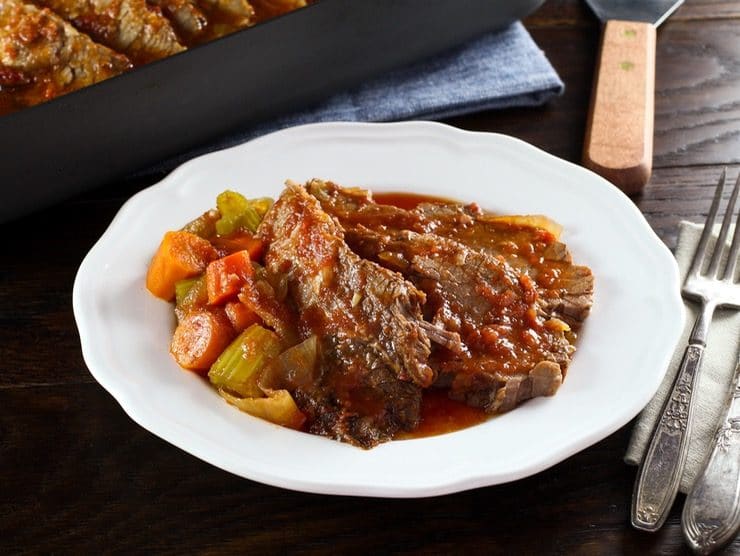
Food Photography and Styling by Kelly Jaggers
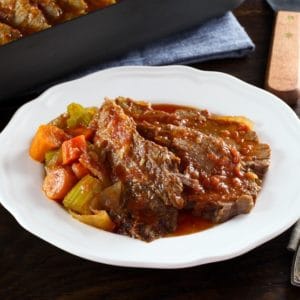
Holiday Brisket
A savory, aromatic, slowly cooked brisket with tomatoes, onions, garlic, brown sugar, and a touch of vinegar. Kosher for Passover, Rosh Hashanah, Hanukkah.
PRINT RECIPE Email Me Recipes
- 5-7 lbs brisket, first or second cut (do not trim fat - especially if it's grass fed)
- 1/4 cup extra virgin olive oil, divided
- 2 large brown onions, peeled and sliced
- 1 lb carrots, peeled and sliced
- 1 lb celery, peeled and sliced
- 28 oz tomatoes - whole, diced, or crushed (1 large can)
- 10 peeled whole garlic cloves
- 1/2 cup brown sugar
- 1/4 cup vinegar (I like apple cider vinegar, but white vinegar works too)
- 2 cups beef or chicken broth, divided
- Salt and pepper
You will also need: Large roasting pan, blender or food processor, large skillet, spatula, parchment paper, aluminum foil, large glass or ceramic baking dish (if making ahead), plastic wrap (if making ahead), sharp carving knife
Gluten Free Note: If you're cooking gluten free, make sure that your packaged products are certified GF.
-
Preheat oven to 300 degrees F. Rinse the brisket and pat dry. Rub both sides of the meat with black pepper and salt.
Heat a large skillet over a medium flame on the stovetop. Drizzle 2 tbsp of olive oil into the pan. Brown the brisket on both sides—it will take 4-5 minutes per side. A large brisket may overlap the edges of the skillet; you can brown it in stages, letting half the brisket overlap the edge, then adjusting it to brown the other half.
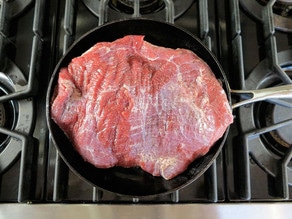
-
While brisket is browning, pour canned tomatoes, garlic, brown sugar, apple cider vinegar, and 1 ½ cups broth into a blender or food processor. Add 2 tsp of salt (or 1 tsp if using a salted kosher cut of brisket) and ¼ tsp of black pepper. Pulse till garlic is chopped small and all ingredients are combined.
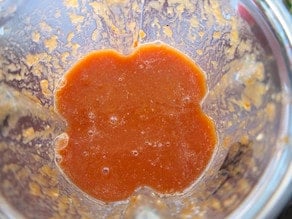
-
Remove the browned brisket from the skillet.
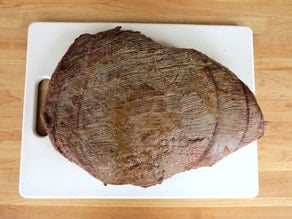
-
Drizzle 2 tbsp more olive oil in the pan and add the sliced onions. Saute them over medium high for a few minutes until they begin to soften and shrink in size.
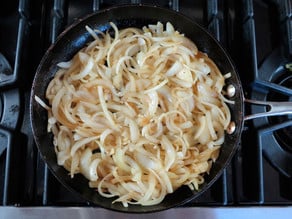
-
Add the carrot and celery slices. Sauté for another 5-6 minutes until the onions are soft and browning and the vegetables are fragrant.
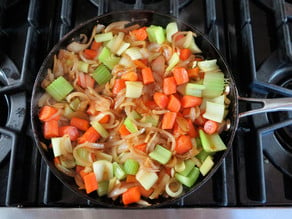
-
Pour the vegetables out of the skillet and onto a plate, reserve. Add 1/2 cup beef stock or chicken stock into the skillet and let it heat up. Use a spatula to gently scrape up any brown bits and pan juices that are clinging to the skillet. Turn off heat.
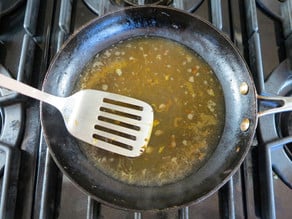
-
Pour half of the tomato mixture into a large roasting pan.
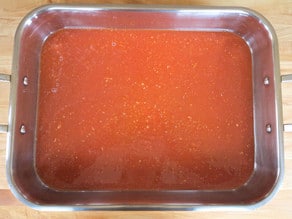
-
Place brisket on top of the tomato sauce, fat cap facing up.
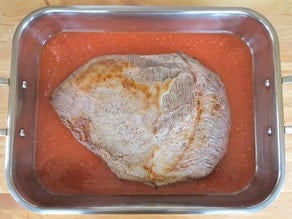
-
Pour the sauteed vegetables across the top of the brisket, along with the broth and brown bits.
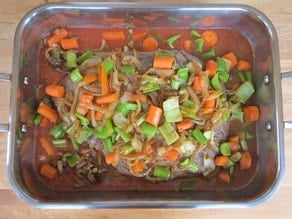
-
Pour the remaining tomato sauce over the top of the vegetables and brisket.
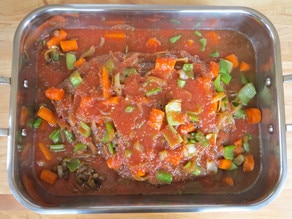
-
Cover the roasting pan tightly with a layer of parchment paper followed by a layer of foil. The parchment forms a protective layer between the meat and sauce (which is acidic) and the foil.
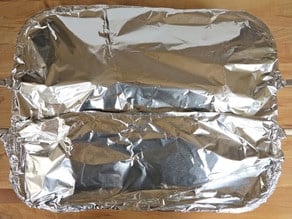
-
Place brisket in the oven. Let it roast undisturbed for 5 to 7 hours. It will take about 1 hour per pound of meat (leaner cuts of meat like grass fed may take longer—test for doneness). Brisket is ready when it flakes tenderly when pierced with a fork. You can let it cook even longer for a soft, shredded texture if that's what you prefer. When fully cooked, the brisket will have shrunk in size.
I recommend making this brisket ahead; allowing it to sit in the refrigerator for 1-2 nights will improve the flavor. If you would like to do this, skip ahead to where it says "Make Ahead Directions." If you are not making ahead, continue reading.
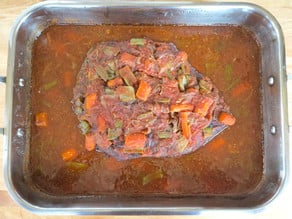
-
Remove brisket from the pan and let it rest on the cutting board fat-side up for 20-30 minutes. Meanwhile, pour the sauce and vegetables from the roasting pan into a smaller saucepan. Skim fat from the surface of the cooking sauce, then reheat the sauce till hot (not boiling).
Cut fat cap off the brisket, then cut the brisket in thin slices against the grain. Serve topped with hot tomato sauce and softened veggies.
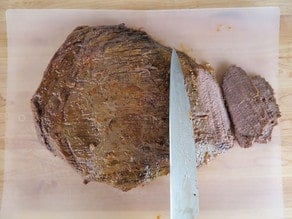
-
Make Ahead Directions: Open the foil to vent and let the brisket slowly return to room temperature. Switch the brisket and sauce to a ceramic or glass dish (metal from the roasting pan can react with the acid in the sauce, which can cause an off taste if left to sit). Cover with plastic wrap and place in the refrigerator. Let the brisket chill overnight, or up to two days. You can also freeze the brisket if you prefer.
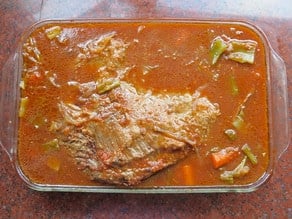
-
1-2 hours before serving, remove the brisket from the refrigerator and preheat your oven to 350 degrees F. The fat in the sauce will have risen to the top, turned white, and solidified. Use a spoon to scoop the fat bits out of the sauce and discard.
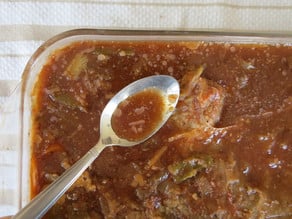
-
Take the brisket out of the dish and brush any excess sauce back into the dish. Place brisket on a cutting board, fat-side up. Slice the meat cold—first cut the fat cap off the brisket, then cut the brisket in thin slices against the grain.
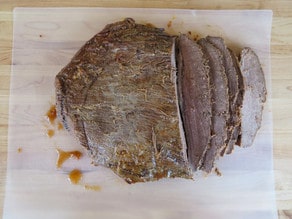
-
Return the sliced meat to the dish and spoon sauce over it, making sure to spoon a little sauce between each slice. Cover the dish with a layer of parchment paper, then with foil, and place it in the oven.
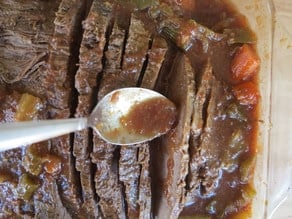
-
Let the brisket roast for 45-60 minutes until heated through. You can cook the brisket even longer to let it become more tender, if you wish. Serve with hot sauce and softened veggies. If you prefer, you can use a slow cooker to reheat. Set the slow cooker to high heat and cook until heated through, about 1 hour.
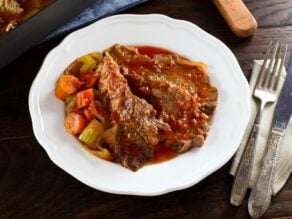
Nutrition Facts
Holiday Brisket
Amount Per Serving
Calories 414 Calories from Fat 162
% Daily Value*
Fat 18g 28%
Saturated Fat 5g 31%
Cholesterol 117mg 39%
Sodium 356mg 15%
Potassium 1080mg 31%
Carbohydrates 19g 6%
Fiber 2g 8%
Sugar 13g 14%
Protein 40g 80%
Vitamin A 7035IU 141%
Vitamin C 17.3mg 21%
Calcium 62mg 6%
Iron 4.2mg 23%
* Percent Daily Values are based on a 2000 calorie diet.

tried this recipe?
Let us know in the comments!
Nutritional information should be considered an estimate only; please consult a registered dietician, nutritionist, or your physician for specific health-related questions. Read more here. Please note that the recipe above is published using a recipe card plugin, with preexisting software which can auto-calculate metric measurements, as well as change the number of servings. Metric conversions and changes to the number of servings (resulting in different ingredient amounts) will only appear in the ingredient list, and are not changed within the step-by-step directions of the recipe.
Source: https://toriavey.com/toris-kitchen/holiday-brisket/

0 Response to "Avery Close Up of Cooked Beef"
Enregistrer un commentaire